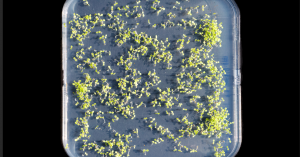When The Dress went viral in 2015—driving tens of millions of online onlookers into existential conniptions over whether the garment was blue and black or white and gold—it didn’t just break the internet, it broke color science as researchers had conceived of it up to that point.
Never before had scientists observed such stark differences of opinion over the color of an object. A popular hypothesis for why people saw the dress differently was color constancy—a perceptual phenomenon by which an object appears to stay more or less the same color, regardless of the lighting conditions under which you see it. It’s an incredible feature of human vision, albeit one that researchers have long used against you in the form of visual illusions. Take this photo, for example, which was created by Japanese psychologist Akiyoshi Kitaoka:
The berries look red, right? They’re not. In fact, there are no red pixels in that image. Go ahead, check. Try using your hands or a few sheets of paper to cover everything but a sliver of strawberry. Trippy, right?
As with the dress, color constancy factors into the explanation. But unlike that dress, nearly everyone perceives Kitaoka’s berries as red. There’s no ambiguity, no fervent disagreement, no philosophical fits. Just a captivating deception, and a robust one at that: Even when you know there are no red pixels, you can’t help but see the berries as red.
The Dress illusion was similarly robust. Mostly. People who saw the outfit as blue and black tended to only see it as blue and black. But the dress could also be mercurial. Every once in a while, without warning, the colors a person perceived might switch, triggering still more existential spasms and additional scientific intrigue.
For the latest episode in our series on the science of illusions, we invited Stanford neuroscientist David Eagleman to help us tackle color constancy: how it enables you to see an object’s true color, even in changing light; how it also makes you susceptible to deception; and what researchers think might be going on in viral photos of ambiguous color illusions like The Dress. Or The Shoes. (What? Don’t tell me you haven’t seen The Shoes …)
More Great WIRED Stories
- The 11 best new TV shows coming this fall
- Watch how to solve a Rubik’s cube, step by step
- College, calculus, and the problem with the SAT
- Why the Porsche Taycan’s two-speed gearbox is such a big deal
- Gaming’s #MeToo moment and the tyranny of male fragility
- 👁 How do machines learn? Plus, read the latest news on artificial intelligence
- 📱 Torn between the latest phones? Never fear—check out our iPhone buying guide and favorite Android phones



